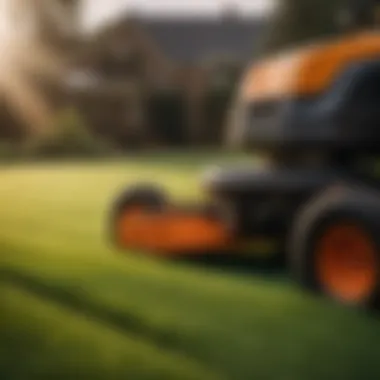Materials:
For the meticulous process of leveling a fescue lawn, you will require a precise set of materials to ensure a flawless outcome. Here is a detailed list of essential items with exact measurements:
- Leveling rake: A high-quality leveling rake with adjustable settings to achieve smoothness (Length: 36 inches)
- Peat moss: Organic matter to enhance soil quality and promote healthy grass growth (Quantity: 10 cubic feet)
- Topsoil: Nutrient-rich soil to level and improve the lawn surface (Quantity: 20 cubic yards)
- Lawn roller: For compacting the soil and ensuring an even finish (Size: 18 inches)
- Water sprinkler: Essential for watering the lawn post-leveling process (Coverage: 5000 square feet)
DIY Steps:
Achieving a flawless fescue lawn surface requires meticulous planning and execution. Follow these detailed instructions to effectively level your lawn:
- Terrain Assessment: Begin by evaluating the terrain to identify uneven areas and dips.
- Soil Preparation: Remove any debris and weeds, and apply peat moss to enhance soil quality.
- Leveling Technique: Utilize the leveling rake to even out the surface, focusing on trouble spots.
- Topdressing: Apply a layer of topsoil evenly across the lawn to achieve consistent coverage.
- Lawn Rolling: Compact the soil using the lawn roller to create a smooth finish.
- Watering: Water the lawn thoroughly to settle the soil and aid grass growth.
Technical Aspects:
To elevate the quality of your DIY fescue lawn leveling project, pay attention to these critical technical aspects:
- Tools: Ensure you have a sturdy leveling rake, quality peat moss, and nutrient-rich topsoil.
- Timing: Plan to execute the leveling process during a dry, calm period to optimize results.
- Techniques: Use firm, consistent strokes with the leveling rake to achieve uniformity.
DIY Project Process:


Follow these sequential steps to transform your fescue lawn into a visually appealing landscape:
- Start Planning: Assess the terrain, gather materials, and plan out the leveling process.
- Executing Techniques: Apply the leveling rake methodically, focusing on achieving evenness throughout.
- Topsoil Application: Spread the topsoil evenly, ensuring comprehensive coverage across the lawn.
- Compact the Soil: Roll the lawn with precision using the lawn roller to create a seamless surface.
- Watering and Maintenance: Thoroughly water the lawn post-leveling and monitor growth progress for optimal results.
Troubleshooting Tips:


In the event of common mistakes or challenges during the leveling process, consider these solutions:
- Unevenness: Reapply topsoil as needed and re-level the surface with the rake.
- Patchy Growth: Overseed areas with sparse grass coverage and ensure adequate watering.
This comprehensive guide equips you with the knowledge and techniques needed to achieve a flawlessly leveled fescue lawn. Elevate your landscape with precision and care, transforming your outdoor space into a visually stunning masterpiece.
Understanding the Terrain


In the intricate process of leveling a fescue lawn, understanding the terrain plays a pivotal role. By assessing the existing landscape and soil composition, homeowners can pinpoint crucial factors that influence the overall success of the leveling project. Terrain evaluation enables individuals to identify slopes, uneven areas, and potential drainage issues that may impact the leveling process. By delving deep into the nuances of the terrain, housewives and homeowners can lay a solid foundation for achieving a flawlessly smooth and visually appealing fescue lawn.
Evaluating the Current State
Assessing Slopes and Uneven Areas
When embarking on the task of leveling a fescue lawn, assessing slopes and uneven areas is paramount. Uneven terrain can result in water pooling, improper grass growth, and an unsightly lawn appearance. By meticulously evaluating slopes and uneven patches, individuals can determine the extent of elevation differences and plan suitable leveling techniques. This step is crucial in ensuring a uniform and aesthetically pleasing surface for the fescue lawn. Homeowners will benefit from a thorough assessment of slopes and uneven areas as it sets the stage for precise leveling methods.
Identifying Drainage Issues
Identifying drainage issues is a crucial aspect of understanding the terrain when leveling a fescue lawn. Poor drainage can lead to waterlogging, root rot, and other detrimental effects on the grass. By pinpointing areas with inadequate drainage, individuals can implement corrective measures such as soil amendments, creating drainage pathways, or installing drainage systems. Recognizing and addressing drainage issues proactively contributes to the long-term health and vitality of the fescue lawn, ensuring optimal growth and appearance.
Soil Analysis and Composition
Testing Soil p
H Levels
Conducting soil pH testing is an essential component of analyzing the soil composition for leveling a fescue lawn. Soil pH influences nutrient availability, microbial activity, and overall grass health. By determining the pH levels of the soil, homeowners can assess whether the soil is acidic, neutral, or alkaline, and make necessary amendments to optimize growing conditions for fescue grass. Understanding soil pH levels equips individuals with valuable insights into soil fertility and helps in strategizing an effective lawn care regimen that promotes robust grass growth.
Determining Soil Texture
Understanding soil texture is vital in comprehending the soil structure and its capacity to retain moisture and nutrients. Different soil textures, such as sandy, loamy, or clay soils, pose varying challenges and advantages when leveling a fescue lawn. By evaluating soil texture, individuals can tailor their soil preparation and maintenance practices accordingly. Soil texture analysis enables homeowners to make informed decisions regarding soil amendments, irrigation frequencies, and grass cultivation techniques, leading to a healthier and more resilient fescue lawn.
Mapping Out the Lawn
Using Surveying Tools
Utilizing surveying tools is instrumental in mapping out a fescue lawn for precise leveling. Surveying tools facilitate accurate measurements of high and low points, contours, and overall terrain gradients. By employing tools such as levels, tape measures, or laser levels, individuals can create a detailed topographic map of the lawn, identifying areas that require elevation adjustments. Mapping out the lawn with surveying tools ensures a systematic and methodical approach to leveling, enhancing the overall effectiveness and precision of the leveling process.
Marking High and Low Points
Marking high and low points on the lawn surface is a critical step in preparing for leveling work. By demarcating areas with elevated spots and depressions, homeowners can strategize the application of leveling materials and techniques more efficiently. Marking high points helps in distributing topdressing material evenly, while marking low points guides the smoothing and contouring process. This meticulous preparation sets the stage for achieving a leveled and well-balanced fescue lawn that boasts a consistent grass surface throughout.
Preparation Steps
In the meticulous process of leveling a fescue lawn, the preparation steps play a crucial role in ensuring a successful outcome. This section focuses on the essential elements that form the foundation of the entire leveling process. It involves clearing the area, aerating the soil, and obtaining necessary tools to streamline the leveling operation. By paying close attention to these preparatory steps, homeowners can set the stage for a flawless and visually appealing result.
Clearing the Area
Removing Debris and Obstacles
Removing debris and obstacles from the lawn surface is a vital initial step in preparing the area for leveling. By clearing out sticks, rocks, branches, and any other debris, you create a clean canvas for the leveling process. This not only enhances the aesthetics of the lawn but also ensures a smoother surface for subsequent leveling techniques. The meticulous removal of debris minimizes the risk of interference during topdressing application and seeding, leading to a more uniform and professional finish.
Trimming Excess Vegetation
Trimming excess vegetation such as overgrown grass, weeds, and plants is equally important in the preparation stage. By trimming vegetation to a uniform height, you create an even surface that facilitates the leveling process. This step allows for better aeration and soil penetration while preventing uneven distribution of topdressing material. Trimming promotes healthier grass growth and contributes to achieving a well-balanced and visually appealing fescue lawn.
Aerating the Soil
Loosening Compacted Soil
Aerating the soil by loosening compacted areas is essential for optimizing root growth and nutrient absorption. Loosening compacted soil promotes better water infiltration and air circulation, crucial for maintaining a healthy lawn. This process enhances the soil's ability to retain moisture and nutrients, promoting robust root development and overall grass vitality. By addressing soil compaction, homeowners can create an optimal environment for establishing a lush and resilient fescue lawn.
Enhancing Root Growth
Enhancing root growth through aeration supports the long-term health and sustainability of the fescue lawn. By aerating the soil, you improve root penetration and proliferation, leading to stronger and more extensive root systems. Deep and healthy roots are essential for withstanding environmental stressors, improving drought tolerance, and enhancing overall grass vigor. This step lays the foundation for a robust and thriving fescue lawn that can withstand varying weather conditions with resilience.
Obtaining Necessary Tools
Lawn Roller
A lawn roller is a key tool in leveling operations, facilitating the smooth and uniform distribution of topdressing material. The lawn roller helps compact the topdressing layer, ensuring proper seed-to-soil contact and moisture retention. Its weighted design enables efficient leveling of the lawn surface, providing an ideal environment for seed germination and grass establishment. Utilizing a lawn roller enhances the effectiveness of other leveling techniques, contributing to the creation of a flawless and picturesque fescue lawn.
Topdressing Materials
Choosing the right topdressing materials is essential for achieving optimal leveling results. Topdressing materials like sand, topsoil, or compost aid in filling low spots, smoothing uneven areas, and improving soil structure. These materials promote a balanced soil composition, enhance drainage, and support healthy root growth. Selecting the appropriate topdressing material based on soil composition and leveling requirements ensures uniform coverage and fosters the development of a lush and vibrant fescue lawn.
Execution of Leveling Techniques
Topdressing Application
Even Distribution of Topdressing Material
The even distribution of topdressing material is a fundamental aspect of achieving a leveled fescue lawn. By ensuring that the topdressing material is spread uniformly across the lawn surface, you can address uneven areas and enhance the overall appearance of the grass. This technique not only helps in leveling the terrain but also aids in providing essential nutrients to the soil, promoting healthy grass growth. The key characteristic of even distribution lies in its ability to create a consistent surface that supports fescue grass's optimal development.
Adjusting Thickness Based on Terrain
When adjusting the thickness of the topdressing material based on the terrain, you tailor the leveling process to meet the specific needs of your lawn. By adapting the thickness according to the elevation changes and soil composition, you can effectively address any irregularities and ensure a balanced lawn surface. This approach allows for precise control over the leveling process, enabling you to achieve a seamless and visually pleasing result. The unique feature of adjusting thickness based on terrain is its ability to customize the application to suit the existing conditions, leading to improved grass health and overall aesthetics.
Dragging and Smoothing
Utilizing Drag Mats
The utilization of drag mats is a key technique in the leveling process, aiding in spreading topdressing material evenly and smoothing the lawn surface. By dragging the mats across the lawn, you can distribute the material effectively, filling in low spots and creating a uniform texture. This method ensures that the topdressing material is incorporated into the grass thoroughly, resulting in a leveled and cohesive appearance. The key characteristic of utilizing drag mats lies in their ability to enhance the blending of the material with the existing grass, promoting seamless integration and a polished finish.
Achieving Uniform Surface
Achieving a uniform surface is essential to the overall success of leveling a fescue lawn. By smoothing out any inconsistencies and leveling the terrain across the entire lawn, you create a visually appealing and well-maintained landscape. This technique helps in eliminating bumps or depressions, ensuring that the grass grows evenly and thrives in a balanced environment. The unique feature of achieving a uniform surface is its capacity to provide a stable foundation for the grass, supporting healthy growth and a pristine appearance.
Maintenance and Aftercare
Regular Monitoring
Inspecting Seed Germination
Inspecting seed germination is a critical aspect of the maintenance and aftercare process of a fescue lawn. This task involves carefully examining the germination progress of the fescue grass seeds planted during the leveling process. By monitoring seed germination, homeowners can assess the success of their seeding efforts and make informed decisions regarding further lawn care practices. The meticulous observation of seed germination is essential for evaluating the overall health and growth of the fescue lawn, ensuring its lush appearance and resilience to environmental stressors.
Addressing Potential Compaction
Addressing potential compaction is another key consideration during the maintenance and aftercare phase of leveling a fescue lawn. Compacted soil can impede the growth of grassroots, limiting the access to water, air, and nutrients essential for healthy plant development. By addressing potential compaction issues through aeration or decompaction techniques, homeowners can rejuvenate the soil structure, promoting robust root growth and optimal lawn health. Managing soil compaction is imperative for maintaining the integrity and vitality of the leveled fescue lawn.
Applying Fertilizer
Feeding the fescue lawn with the right balance of nutrients is essential for sustaining its health and vibrancy. Balancing nutrient levels through strategic fertilizer applications aids in fortifying the grass with essential elements for growth and resilience. This meticulous process of nutrient management contributes to the overall nourishment of the lawn, promoting its lush green hue and dense texture. Understanding the unique nutritional requirements of fescue grass and tailoring fertilizer applications accordingly is paramount for fostering a thriving and visually appealing landscape.
Promoting Healthy Growth
Promoting healthy growth through targeted fertilization practices is a fundamental aspect of maintaining a fescue lawn post-leveling. By providing the grass with specific nutrients needed for vitality and strength, homeowners can encourage robust growth and development. The promotion of healthy growth not only enhances the aesthetic appeal of the lawn but also increases its resistance to diseases and environmental stressors. By adopting a proactive approach to nurturing the fescue lawn through fertilizer applications, individuals can ensure long-term sustainability and beauty.
Mowing and Trimming
Mowing and trimming serve as essential maintenance practices for preserving the neatness and uniformity of a leveled fescue lawn. Maintaining optimal grass height through regular mowing sessions helps regulate the growth of the fescue grass, preventing it from becoming overgrown or patchy. The meticulous process of mowing at the correct height ensures a uniform appearance across the lawn, enhancing its visual allure and health. Additionally, edging for a defined finish adds a finishing touch to the landscape, delineating the boundaries of the lawn and enhancing its overall aesthetic appeal. Striving for precision and consistency in mowing and trimming practices is key to upholding the impeccable look of a leveled fescue lawn.





